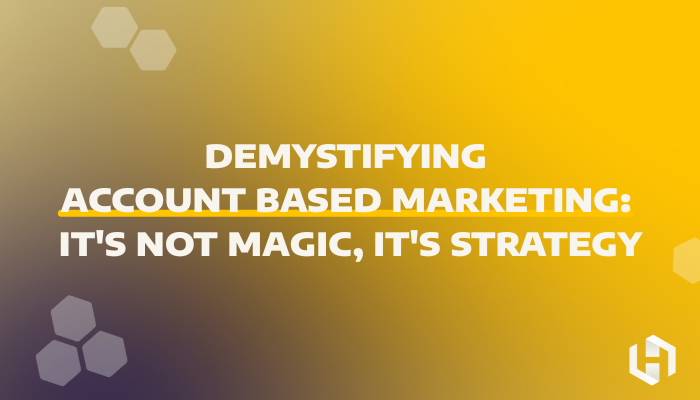Account Based Marketing (ABM) often appears to be a mystical concept to many marketers, but in actuality, it is a strategic and targeted approach that hones in on high-value accounts. This blog post aims to dispel any misconceptions surrounding ABM and provide a clear understanding of what this innovative strategy truly entails.
Unveiling the Secrets of Account Based Marketing
ABM Is Not Just for Large Enterprises
Many believe ABM is only for giant corporations with massive budgets. Businesses of all sizes can benefit from ABM. The key is to identify and prioritize your most valuable accounts, regardless of your company’s size. Small businesses can also leverage ABM by focusing their resources on high-potential clients.
ABM Is Not One-Size-Fits-All
ABM isn't a single, rigid strategy. It's customizable. Tailor your approach to the specific needs and goals of each account. This might involve personalized content, bespoke campaigns, or unique offers. Flexibility is your friend here. By adapting your strategy to each account, you can address their unique challenges and opportunities.
ABM Is Not Only About Sales
While sales play a big role, ABM is a collaborative effort between marketing and sales teams. Marketing generates awareness and engagement. Sales focuses on closing deals. Both teams must work in harmony to create a seamless experience for the account. When marketing and sales align, they can create a more effective and cohesive strategy.
ABM Is Not Complicated
ABM may sound complex, but with the right tools and strategy, it can be straightforward. Start by identifying target accounts, creating tailored content, and aligning your sales and marketing efforts. Consistent evaluation and adjustment will keep your ABM strategy on track. By breaking down the process into manageable steps, you can implement ABM with ease.
ABM Does Not Ignore Existing Customers
A common misconception is that ABM only focuses on acquiring new customers. ABM also emphasizes nurturing and expanding relationships with existing customers. By applying ABM principles to your current client base, you can identify new opportunities for growth and strengthen customer loyalty. This approach can lead to higher customer retention and increased revenue from existing accounts.
How to Get Started with ABM
1. Identify your high-value accounts. Look at your current customer base and pinpoint the clients that bring the most value to your business. Research these accounts to understand their needs, challenges, and goals.
2. Create personalized content. Develop content that speaks directly to the needs and interests of your target accounts. This could include blog posts, case studies, whitepapers, or webinars. The more tailored your content, the more likely it will resonate with your audience.
3. Align your sales and marketing teams. Ensure both teams are working together towards common goals. Regular communication and collaboration are key to a successful ABM strategy. Use tools and platforms that facilitate this alignment and track progress.
4. Evaluate and adjust your strategy. Monitor the performance of your ABM campaigns and make adjustments as needed. Look at metrics such as engagement, conversion rates, and revenue to gauge success. Continuous improvement will help you refine your approach and achieve better results.
Ready to Build Your ABM Strategy?
ABM isn't magic—it's a well-planned strategy that can drive significant results for your business. Whether you're a small business or a large enterprise, ABM can help you focus your efforts on the accounts that matter most. Reach out today, and let's demystify ABM together.
Still have questions on ABM? Join our upcoming HubSpot User Group event where you'll have the opportunity to get your questions answered by industry experts from HubSpot, RollWorks and HIVE Strategy.




.png?width=100&height=100&name=Why%20Were%20Not%20a%20Marketing%20Agency%20(And%20What%20That%20Means%20for%20Your%20Growth).png)
